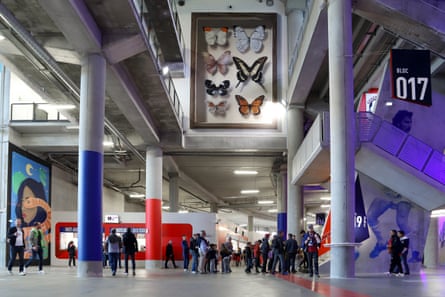
Stade de Lyon
Capacity for the tournament 57,900
Completed January 2016
Matches at France 2019 Semi-finals, 2/3 July; Final, 7 July.
History lesson: During construction work builders found artefacts dating back to the Roman occupation of Gaul around the 1st century BC, including an iron spear, shields and human skulls. Those are now on display in the city’s Gallo-Roman museum, while the stadium, designed by the same architects who built the Emirates and the new Tottenham Hotspur stadium, has a proudly modern feel. It is one of the few in France actually owned by the club that plays in it, with Lyon having spent around £500m to develop a complex that can sustain its aspirations to be one of Europe’s elite clubs.




Star attraction Developers placed an emphasis on spectators’ comfort, providing for unusually ample leg room – and not just in the 6,000 VIP seats. But soon after its opening Lyon supporters complained that all the bare grey concrete in the corridors around the ground made for a dull experience, so there is now an on-site gallery – called the Offside Gallery – that hires artists to paint works directly on to the walls and “express the essence of urban culture”.
They said “I dreamed of scoring the first goal here and I’ve managed to achieve that, which is something no one can ever take away from me” – Alexandre Lacazette after opening the scoring in the first match in the stadium, Lyon’s 4-1 victory over Troyes in January 2016.

Stade des Alpes, Grenoble
Capacity 18,000
Completed February 2008
Matches at France 2019 Brazil v Jamaica, 9 June; Nigeria v South Korea, 12 June; Canada v New Zealand, 15 June; Jamaica v Australia, 18 June; Round of 16, 22 June.
History lesson The decision to build a new and improved stadium on the site of the former Stade Charles Berty in the centre of Grenoble enraged many. Construction was delayed for several years as protestors occupied the ancient trees that were eventually chopped down to accommodate the Stade des Alpes. Designers made a sporting virtue of placing the stands close to the touchline “in the English style” and made a nod to environmentalism by fitting the glass roof with a solar panel that provides 20% of the stadium’s energy needs. The home to a second-tier football club and top-flight rugby club is seldom full.
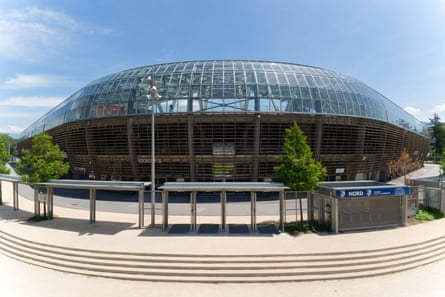

Star attraction Having replaced the arena that bore his name, the Stade des Alpes was, in 2010, given a plaque commemorating Charles Berty, a former Tour de France cyclist who fought in the resistance before being betrayed and sent to his death at Mauthausen concentration camp.
They said “I can let my predators fly in a magnificent place” – Tahar Méguireche, whose three Harris’s hawks were invited to spend several months in the stadium in 2015 to scare off crows, who had pecked away seals in the glass roof, leaving holes that let rain water fall on fans.
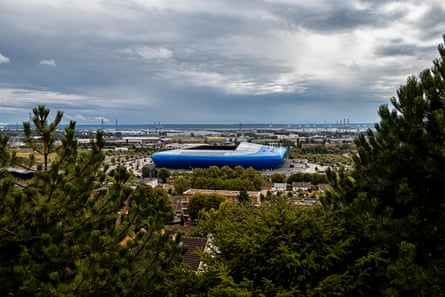
Stade Océane, Le Havre
Capacity 24,000
Completed July 2012
Matches at France 2019 Spain v South Africa, 8 June; New Zealand v Netherlands, 11 June; England v Argentina, 14 June; China v Spain, 17 June; Sweden v USA, 20 June; Round of 16, 23 June; Quarter-final, 27 June.
History lesson The stadium, designed by the firm who later rejigged London’s Olympic Park for West Ham, was built on an old railyard as a new home for Le Havre. That club, now in the second tier, was founded by British immigrants in 1872, the same year as Rangers, which is why the Scottish side were invited to contest the first match at Stade Océane in 2012. They had to pull out because of financial mismanagement so Le Havre played against local rivals Lille instead. The arena also played host to Didier Deschamps’ first match as France manager in 2012.

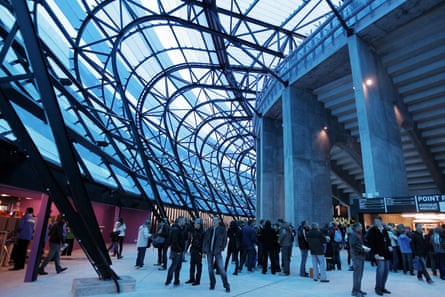


Star attraction Designers claim built-in solar panels and other technical touches make this Europe’s first “positive energy” stadium, producing more energy than it consumes. Whatever about its green credentials, the exterior definitely reflects the stadium’s name thanks to a mass of pixelated ocean blue polymer shells.
They said “Management, staff, players: hang on to 10th place, you’re great” – a sarcastic banner displayed by Le Havre fans before a pitch invasion to protest at a home defeat by Quevilly-Rouen Métropole in March 2018, which led to a one-game stadium closure.
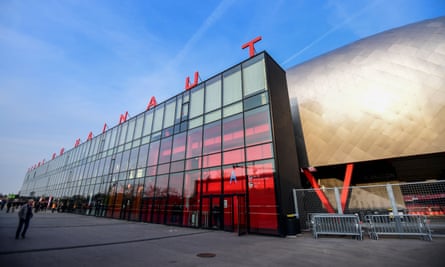
Stade du Hainaut, Valenciennes
Capacity 22,600
Completed July 2011
Matches at France 2019 Australia v Italy, 9 June; Germany v Spain, 12 June; Netherlands v Cameroon, 15 June; Italy v Brazil, 18 June; Round of 16, 23 June; Quarter-final, 29 June.
History lesson Valenciennes gets its name from Valentinian I, a particularly boorish Roman emperor notorious for his violent hatred of finery and learning. Yet the city boasts a rich cultural heritage, a home to artists and architects, and the Stade du Hainaut has a bijou charm. It was built just a stone’s throw from the Stade Nungesser which had been Valenciennes’ den since 1930 and when full it helps generate a vibrant atmosphere. Pity the host club is in Ligue 2, having been relegated from the top flight soon after their new home’s completion.


Star attraction Digging was done so that the pitch could be laid below sea level, enabling the stadium to become a tasteful low-rise structure, with the top just 21 metres high. The ensemble has an aluminium cover that gleams in the sunlight to give the impression of a sweet with a nice foil wrapper.
They said “The chairman took the liberty of putting the trophy in his office. I’m a little annoyed about that because I’m the one who won it” – Frédéric Sauvage, whose antics while dressed as a giant swan got him voted the Ligue 1 mascot of the year in 2013.

Roazhon Park, Rennes
Capacity 28,600
Completed 2004
Matches at France 2019: Germany v China, 8 June; USAChile v Sweden, 11 June; Japan v Scotland, 14 June; Nigeria v France, 17 June; Thailand v Chile, 20 June; Round of 16, 25 June; Quarter-final, 29 June.
History lesson Built in 1912, the stadium, originally named Stade de la Route de Lorient, has been renovated many times, including a complete revamp in 2004. The first major expansion was in 1932 after a crowd of 8,000 turned up to watch an exhibition match against none other than Mansfield Town. American soldiers were garrisoned in the stadium during the second world war. The stadium’s current name was chosen by a popular vote in 2015 – Roazhon means “Rennes” in Breton – when all the seats were replaced by exclusively red ones, the colours of the local club.




Star attraction Unremarkable aesthetically, the stadium does at least lend to a decent atmosphere. Oh, and locals have a particular fondness for banners and flags. In 2018 they unfurled a 1,395m2 Gween Ha Du (flag of Brittany), reclaiming a record taken from them two years previously by neighbours Lorient.
They said “People don’t realise it’s a factor for us. There’s so much noise that we can’t even hear each other on the pitch” – England’s Rachel Yankey in 2006, when a 1-1 draw with France at Roazhon Park qualified Hope Powell’s team for the World Cup.
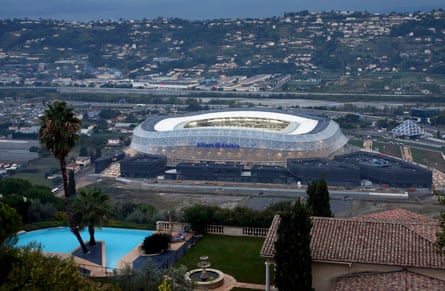
Stade de Nice
Capacity 35,100
Completed September 2013
Matches at France 2019 England v Scotland, 9 June; France v Norway, 12 June; Sweden v Thailand, 16 June; Japan v England, 19 June; Round of 16, 22 June; Third place play-off, 6 July.
History lesson For more than 80 years Nice played their home matches in the Stade du Ray, an atmospheric arena in the heart of the city. The ground grew obsolete and was replaced by a bigger and swisher venue, which is awkward to get to and too open to be called a cauldron even on the rare occasions it is full. Still, back in the town fans of England, who will play at least two matches in Nice this summer, can enjoy a pre-match stroll by the Mediterranean along the Promenade des Anglais, just like the 18th-century aristocrats after whom the walkway is named.


Star attraction No matter what is happening on the pitch, spectators can delight in the view of the Alps from the stands. Also, thanks to its transparent shell, the ground is well lit by sunlight during the day and emits a radiant glow during floodlit games.
They said: “Booooooooooooooo” – Nice fans drown out the songs of the singer Patrick Bruel, who was invited to perform at the stadium’s opening in 2013 despite being a prominent supporter of PSG.

Parc des Princes, Paris
Capacity 47,600
Completed Refurbished in 2015
Games at France 2019 France v South Korea, 7 June; Argentina v Japan, 10 June; South Africa v China, 13 June; USA v Chile, 16 June; Scotland v Argentina, 19 June; Round of 16, 24 June; Quarter-final, 28 June.
History lesson One of France’s oldest stadiums, the Parc des Princes was built in 1897 an originally used as the finishing line of the Tour de France. It first hosted World Cup matches at the men’s tournament of 1938. The current version of the stadium was erected in 1972 and has undergone two refurbishments since then, most recently for Euro 2016. It has been the home of Paris Saint-Germain since 1974. Its tight design and acoustics make for a thrilling atmosphere when fans are in the mood.




Star attraction The concrete exterior is spliced by a series of razor-like shards, a unique ensemble that drivers should not spend too much time admiring as they zoom along with Parisian ring road that runs underneath it.
They said “I’ve played in some stadiums that transmit a fantastic atmosphere, such as the Maracaña, the San Siro and the Vélodrome” – PSG captain Thiago Silva had some explaining to do in June 2018 after acclaiming the home of Marseille rather than the Parc de Princes.

Stade de la Mosson, Montpellier
Capacity 19,300
Completed Opened in 1972, renovated many times, most recently in 2017
Matches at France 2019 Canada v Cameroon, 10 June; Australia v Brazil, 13 June; South Africa v Germany, 17 June; Cameroon v New Zealand, 20 June; Round of 16, 25 June.
History lesson Nicknamed, among other things, “the giant’s pothole” by fans during the 1970s because it was so underdeveloped that one could look down on its from surrounding trees, the stadium has undergone several expansions and renovations since then, most notably when it was almost entirely rebuilt before the 1998 World Cup. Montpellier, who seldom fill it, are unlikely to call it home for much longer, as plans are afoot to build a new ground by 2022 in a part of the city not prone to flooding from the river that gives the Stade de la Mosson its name.


Star attraction The view of the pitch is not ideal from the top of the uncovered three-tiered stand that rises out of all proportion to the rest of the stadium, but the view of the surrounding countryside is spectacular. It can get a bit chilly up there, though, and the layout makes for bad acoustics.
They said “There is more than three metres of water. There are no more dressing rooms, they’re just mud. Part of the pitch has floated off into the lovely Mediterranean” – Montpellier deputy chairman Laurent Nicollin after flooding in 2014 that led to the stadium being closed for three months of repairs.
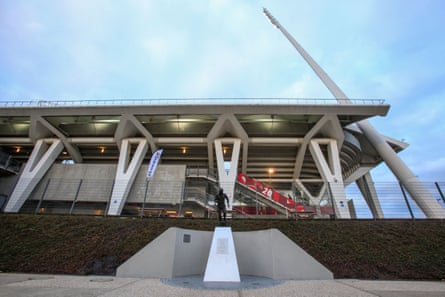
Stade Auguste-Delaune, Reims
Capacity 20,500
Completed 2008
Matches at France 2019 Norway v Nigeria, 8 June; USA v Thailand, 11 June; Jamaica v Italy, 14 June; South Korea v Norway, 17 June; Netherlands v Canada, 20 June; Round of 16, 24 June.
History lesson Known as the Stade Municipal when it was built in 1935, the stadium was later renamed in honour of Auguste Delaune, a former sports administrator and communist activist who fought in the Resistance before being tortured to death by the Gestapo in 1943. The stadium was home to the Stade de Reims men’s team for whom the term “champagne football” was invented when they won three French titles in the 1950s and reached two European Cup finals. It was revamped in 2008.


Star attraction The floodlights, borne on four 75m masts that soar high above the rest of the stadium, can be seen for miles and lean inwards as if following the action on the pitch. They are “like cathedral spires”, according the designers of a structure that also looks like a giant toothbrush holder from afar.
They said Nothing. Having been invited to perform a ceremonial kick-off before a charity match in March, Brigitte Macron, wife of France’s president, stayed in the stands after her name was whistled and booed.
